Complainant Consultation regarding the Office of the Information Commissioner’s Investigations Program
Contents
- Executive Summary
- 1. Data Collection Methodology
- 2. Findings
- 3. Key Takeaways: Strengths and Areas for Improvement in the Investigations Program
- 4. Recommendations
- 4.1 Develop and Implement a client-facing Complaint Management System
- 4.2 Improve the OIC Website
- 4.3 Standardize and Optimize Investigation Processes
- 4.3 Improve Collaboration and Communication with Institutions
- 4.4 Simplify the Interpretation of the Act
- 4.5 Publish Investigation Outcomes
- 4.6 Change Management
- 4.6 Advocate for Improvements to the Act
- Appendix I: Self-Identification of Complainants
- Appendix II: Questionnaire
- Appendix III: Focus Group Guide
Executive Summary
The Office of the Information Commissioner of Canada (OIC) investigates complaints from requesters who believe institutions did not respect their rights under the Access to Information Act (the Act). The OIC collected data from individuals to better understand their experiences during the complaint and investigation processes, via a third-party contractor, in order to ensure that the process maintained confidentiality. Individuals registered to participate in advance via Microsoft Forms; registered individuals were sent the questionnaire link or contacted via telephone by the third-party contractor. Among the 62 respondents who registered, 40 individuals completed the questionnaire, giving a response rate of 64.5%. Among the 40 respondents, 10 individuals expressed interest and 5 participated in focus group sessions.
The comments and conclusions within this report reflect the unique perspectives of the individuals who participated. The third-party contractor did not validate these perspectives against the OIC’s business processes or communications strategies, nor did it evaluate the OIC’s business processes or resource allocation.
The questionnaire included optional self-identification questions and closed- and open-ended questions to assess complainants’ perspectives towards the following aspects of the OIC’s Investigations Program:
- Gathering information from the OIC’s website
- Submitting a complaint
- Complaint admissibility process
- Complaint assignment and investigation
- Investigation conclusion
Focus group discussions also put emphasis on these areas. Analysis of the responses from the questionnaire and focus groups helped identify several key themes:
- Communications: The OIC’s communications via different channels and at different stages of the Investigations Program are clear and easy to understand. However, there is an opportunity to improve the amount and quality of information shared with complainants; for example, the OIC may consider improving the sharing of information related to closed investigations, including making available real-time/up-to-date statistics on closed investigations on its Website. The OIC may also consider implementing a client-facing online case management system for complainants to access their complaints, to track the status of their complaints and to submit representations or other documentation.
- Process Timelines: The long timelines throughout the investigation process is a key challenge faced by complainants, as it can vary from a few months to several years. The OIC may consider adding additional staff and/or re-evaluating its processes to identify efficiencies.
- Investigation Process: The investigation process is perceived to be fair, barrier-free and safe for complainants. However, complainants also identified a need for increased communication of its service standards, expected timelines and next steps which would best manage complainant expectations.
- Promoting Inclusive Behaviour: There is an opportunity to provide additional learning for the OIC’s staff, focused on inclusive communications and behaviour and adopting a trauma-informed lens in their work, to promote an inclusive approach towards complainants.
- Accountability of Institutions: Complainants perceive that institutions are not held to account by the OIC (for example, long time extensions taken under section 9 of the Act). There is an opportunity for investigators to collaborate with institutions and to improve communications with complainants.
- Improved Communication of Interpretations of the Act: While most participants agree that the information found on the OIC’s website is what they need and easy to find, there is an opportunity to provide updated guidance and interpretation of the various provisions found in the Act.
- Change Management: As the OIC reviews its processes and implements any of the recommendations made following this consultation, changes will have internal and external impacts, hence there is an opportunity to integrate change management practices. The OIC should consider integrating change management practices in day-to-day and operational processes to ensure complainants, employees and institutions are well equipped to adapt. For example, before announcing any process or policy change, the OIC should undertake communication and change management activities.
1. Data Collection Methodology
1.1. Questionnaire
The OIC collected data from existing and/or potential complainants. The Investigations Program is designed to investigate complaints about how federal institutions process access to information requests, made under the Act. The OIC gathered data via an online and telephone questionnaire facilitated by a third-party contractor from individuals who chose to be a part of the process. 62 individuals registered to participate in either English or French and a total of 40 responses (response rate of 64.5%) were received. All questionnaire responses received have been included as part of this report.
The focus of the questionnaire was on assessing the effectiveness, accessibility and ease of use of the Investigations Program for complainants. The questionnaire consisted of closed- and open-ended questions to assess the perspectives of complainants towards different aspects of the Program including:
- Gathering information from the OIC’s website
- Submitting a complaint
- Complaint admissibility process
- Assigning and investigating complaints
- Providing outcomes of an investigation
In addition, the questionnaire also included 6 optional self-identification questions focused on age, disability, gender identity, sexual orientation, Indigenous identity and ethnic and racial identity of individuals. This report includes both quantitative and qualitative analysis to capture the respondents’ perspectives in detail.
1.2. Focus Group
Among the 40 individuals who responded to the questionnaire, 10 expressed interest and were given three time and date options for virtual focus group sessions. A total of 7 individuals registered for 2 English sessions and 5 attended. Once the participants had chosen preferences, a Microsoft Teams meeting invitation with a focus group guide was sent to them. The focus group guide included questions for discussions and instructions for joining the session via Microsoft Teams. Both sessions were 60 minutes long and focused on the following areas:
- Gathering information from the OIC’s website
- Submitting a complaint
- Complaint admissibility process
- Assigning and investigating complaints
- Providing outcomes of an investigation
The comments and conclusions within this report reflect the unique perspectives of the individuals who participated. The third-party contractor did not validate these perspectives against the OIC’s business processes or communications strategies, nor did it evaluate the OIC’s business processes or resource allocation with respect to the investigations program.
2. Findings
2.1 Overview of the Complainants
Of the 40 questionnaire respondents, 25 reported that they had submitted a complaint to the OIC in the past, 12 reported that they have not submitted a complaint to the OIC in the past and 3 chose not to respond.
Among the respondents who reported having submitted a complaint, 92% (23) submitted their last complaint in 2023 and the remaining (2) submitted their complaints between 2020 and 2022. All individuals who participated in the focus group sessions have submitted multiple complaints.
2.2 The OIC’s Website
All 40 questionnaire respondents answered this section and 17 of them left comments.
The OIC’s website is easy to understand and provides relevant information to most people. The use of different communication elements is overall inclusive, but the ease of navigation can be improved.
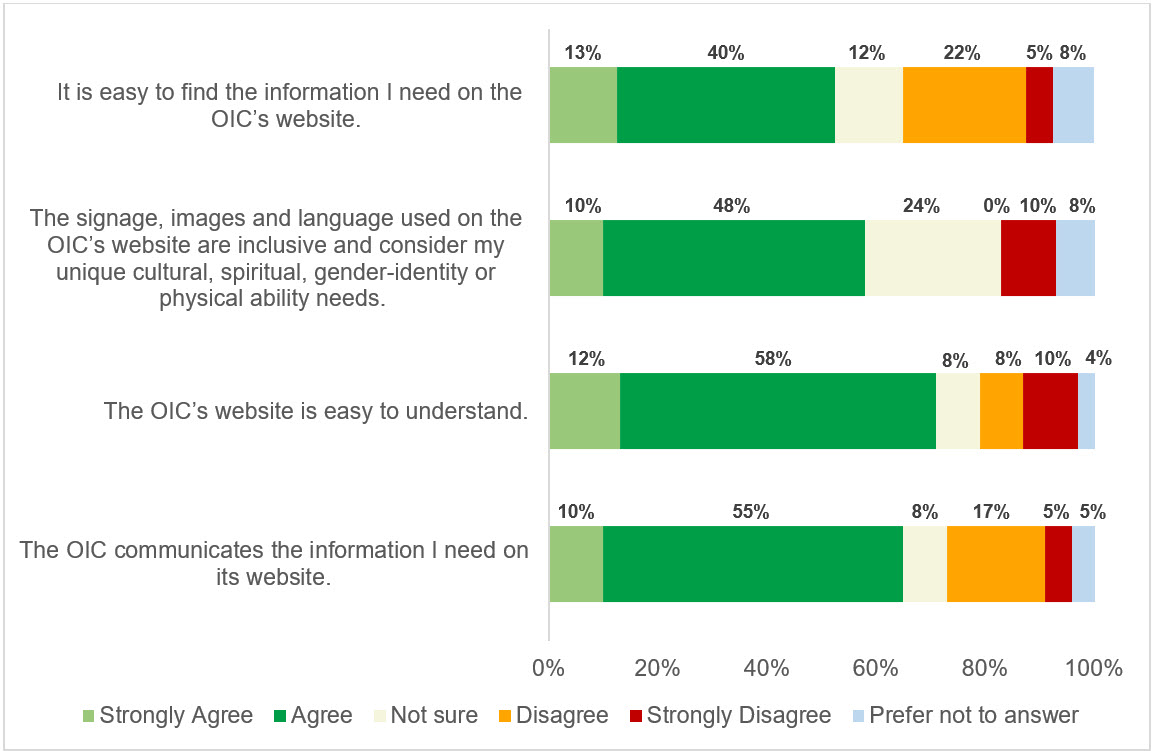
Text version
This bar chart shows the results by percentage to the following statements.
It is easy to find the information I need on the OIC’s website: 13% Strongly Agree, 40% Agree, 12% Not Sure, 22% Disagree, 5% Strongly Disagree, 8% Prefer not to answer
The signage, images and language used on the OIC’s website are inclusive and consider my unique cultural, spiritual, gender-identity or physical ability needs: 10% Strongly Agree, 48% Agree, 24% Not Sure, 0% Disagree, 10% Strongly Disagree, 8% Prefer not to answer
The OIC’s website is easy to understand: 12% Strongly Agree, 58% Agree, 8% Not Sure, 8% Disagree, 10% Strongly Disagree, 4% Prefer not to answer
The OIC communicates the information I need on its website: 10% Strongly Agree, 55% Agree, 8% Not Sure, 17% Disagree, 5% Strongly Disagree, 5% Prefer not to answer
Areas of Strengths
- 58% (23) of questionnaire respondents “agree” that the OIC’s website is easy to understand and 55% (22) of respondents “agree” that it communicates the information that they need. Focus group participants echoed similar opinions confirming that the OIC’s website is easy to use.
- Some (6) questionnaire respondents mentioned that the content on the website is easy to understand.
Improvement Opportunities
- The OIC could develop a process to regularly check if all website links are functioning as some respondents commented that the links on the website do not work at all times. Additionally, there is an opportunity to allow global access to the website, as some focus group participants mentioned inability to access the website and/or submit complaints from outside Canada.
- A simple explanation of the Access to Information Act on the website could be helpful to some questionnaire respondents who stated that they find it difficult to understand the legal language and/or do not want to read the whole Act. Several focus group participants suggested updating and publishing the OIC’s Investigator’s Guide to Interpreting the Act.
- The OIC could improve its website’s navigation features by minimizing pages and sub-pages and improving functionalities such as the search function. 23% (9) of questionnaire respondents “disagree” and 5% (2) “strongly disagree” with the process of finding information on the OIC’s website being easy. Some focus group participants suggested adding a help section on the website.
- Some (5) questionnaire respondents stated that the website should provide additional information; for example, the website could include:
- Publication of all final reports for all investigations along with an RSS feed to view new publications or final reports when they have been published;
- Information regarding alternative options for individuals who have not made a complaint within the 60-day timeframe to do so;
- Service standards or timeframes for investigating complaints.
- Focus group participants identified the need for a client-facing online case management system for complainants to access their complaints, to track the status of their complaints and to submit representations or other documentation.
2.3 Submitting a Complaint
Thirty eight (38) questionnaire respondents answered this section and 13 of them left comments.
The OIC’s complaint form is easy to use and allows individuals to file multiple complaints together but can have higher character limit and more parameters for complainants to provide information.
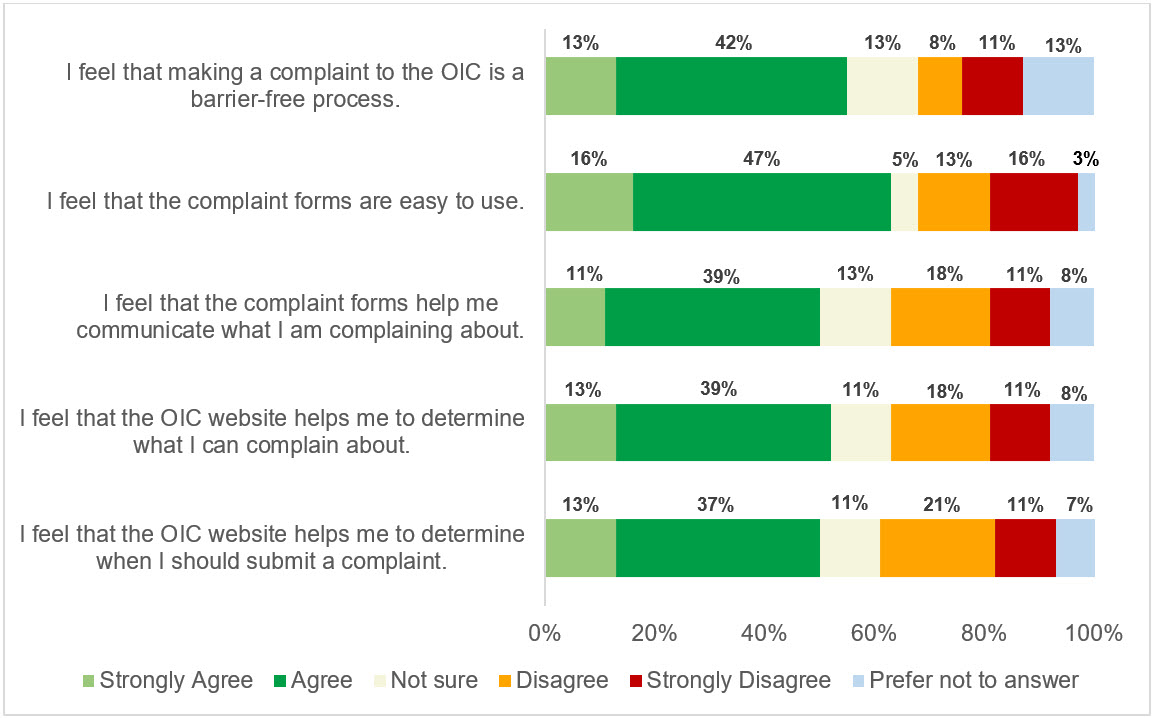
Text version
This bar chart shows the results by percentage to the following statements.
I feel that making a complaint to the OIC is a barrier-free process: 13% Strongly Agree, 42% Agree, 13% Not Sure, 8% Disagree, 11% Strongly Disagree, 13% Prefer not to answer
I feel that the complaint forms are easy to use: 16% Strongly Agree, 47% Agree, 5% Not Sure, 13% Disagree, 16% Strongly Disagree, 3% Prefer not to answer
I feel that the complaint forms help me communicate what I am complaining about: 11% Strongly Agree, 39% Agree, 13% Not Sure, 18% Disagree, 11% Strongly Disagree, 8% Prefer not to answer
I feel that the OIC website helps me to determine what I can complain about: 13% Strongly Agree, 39% Agree, 11% Not Sure, 18% Disagree, 11% Strongly Disagree, 8% Prefer not to answer
I feel that the OIC website helps me to determine when I should submit a complaint: 13% Strongly Agree, 37% Agree, 11% Not Sure, 21% Disagree, 11% Strongly Disagree, 7% Prefer not to answer
Areas of Strengths
- 47% (18) of questionnaire respondents “agree” and 16% (6) of them “strongly agree” that the complaint forms are easy to use.
- 42% (16) of questionnaire respondents “agree” and 13% (5) of them “strongly agree” that the complaint process at the OIC is barrier-free.
- Respondents find the complaint form to be a generally easy to use. Some of them reported that the form breaks down barriers by providing different blocks for providing information in separate groupings and by allowing individuals to file multiple complaints at the same time.
- Focus group participants reported the use of emails for filing complaints as an easy alternative to complaint forms.
Improvement Opportunities
- Some focus group participants reported the complaint-form getting timed out while they are filling it, suggesting an opportunity to add auto-save feature, provide a timing warning, and/or increase timeout duration.
- Some (2) questionnaire respondents stated that the 500-character limit is not enough for them to share all the details related to a complaint. Even though focus group respondents mentioned the ability to share details during later stages in the process, there is an opportunity to increase the character and/or word limit of the complaint form such that the respondents can share all relevant information.
- The OIC should consider making the website and complaint form accessible worldwide.
- The parameters provided in the form can be further expanded as some respondents mentioned that the given parameters do not cover all aspects of the complaint.
- Some respondents mentioned the 60-day time limit set in the Act to making a complaint as being restrictive and that the OIC’s recent enforcement of the 60-day time limit for delay complaints was made with little notice to complainants about the change. The OIC should consider change management to enable complainants the opportunity to adapt to the change.
2.4 Overview of Complaints Submitted
Thirty-seven (37) respondents answered this section.
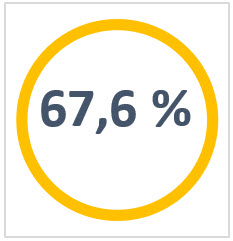
(25) of respondents who answered this question submitted a complaint to the OIC. 40% (10) of them have submitted 1 to 10 complaints, 24% (6) have submitted 21 to100 complaints and 24% (6) of them have submitted more than 100 complaints to the OIC to date.
92% (23) of these respondents submitted their last complaint in 2023 and the remaining submitted their complaints between 2020 and 2022.
2.5 The Registry Admissibility Process
Twenty five (25) questionnaire respondents answered this section and 12 of them left comments. The OIC’s Registry receives and determines whether complaints are admissible—that is, whether they include all the necessary details, were submitted by the 60-day deadline, are not premature and fall within the Commissioner’s mandate.
The OIC’s Registry admissibility process is easy to follow and the Registry provides a reasonable time to complainants for sharing information but there is an opportunity to make the process faster.
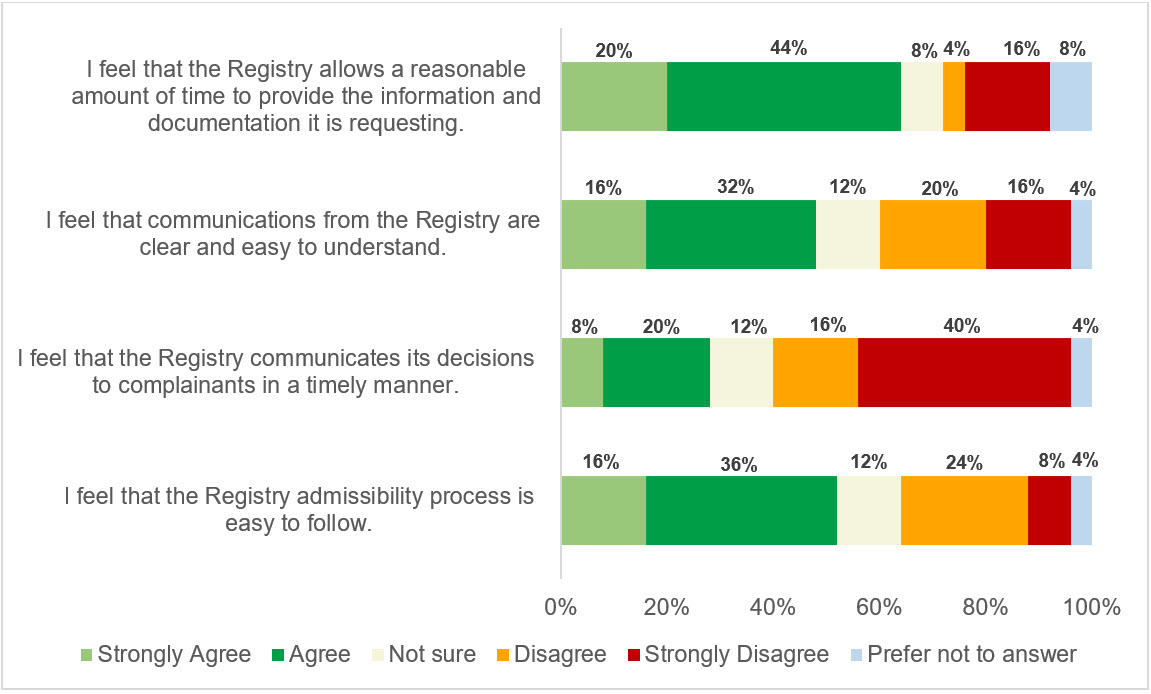
Text version
This bar chart shows the results by percentage to the following statements.
I feel that the Registry allows a reasonable amount of time to provide the information and documentation it is requesting: 20% Strongly Agree, 44% Agree, 8% Not Sure, 4% Disagree, 16% Strongly Disagree, 8% Prefer not to answer
I feel that communications from the Registry are clear and easy to understand: 16% Strongly Agree, 32% Agree, 12% Not Sure, 20% Disagree, 16% Strongly Disagree, 4% Prefer not to answer
I feel that the Registry communicates its decisions to complainants in a timely manner: 8% Strongly Agree, 20% Agree, 12% Not Sure, 16% Disagree, 40% Strongly Disagree, 4% Prefer not to answer
I feel that the Registry admissibility process is easy to follow: 16% Strongly Agree, 36% Agree, 12% Not Sure, 24% Disagree, 8% Strongly Disagree, 4% Prefer not to answer
Areas of Strengths
- 44% (11) of questionnaire respondents “agree” and 20% (5) of them “strongly agree” that the Registry provides a reasonable amount of time to complainants to provide requested information and documentation. Focus group participants added that the opportunity to submit additional information at this stage helps strengthen their allegations and underlying explanations.
- 32% (8) of questionnaire respondents “agree” and 16% (4) of them “strongly agree” that the Registry’s communications are clear and easy to understand.
- One of the questionnaire respondents stated that they were permitted to submit representations even if the complaint was considered inadmissible, which makes their experience positive. The respondent added that the process led to a written decision from the Commissioner that was also posted on the website.
Improvement Opportunities
- 40% (10) of questionnaire respondents “strongly disagree” and 16% (4) “disagree” that the Registry communicates its decisions in a timely manner. Some respondents mentioned that they have to wait a long time to hear from the Registry after initial acknowledgment. The OIC’s internal processes as well as resource allocation was not within the scope of this report. That said, these comments suggest the need to increase capacity in order to register complaints more quickly.
- Focus group participants reported an issue of missing emails and complaints at the Registry level, potentially due to the use of a single inbox by multiple individuals.
- There is an opportunity for the Registry to make information more accessible for complainants by implementing a client-facing online case management system for complainants to access their complaints, to track the status of their complaints and to submit representations or other documentation and/or by providing them with a brief description of the request in the email body, should the case management system not be feasible.
2.6 Complaint Assignment and Investigation
Twenty five (25) questionnaire respondents answered this section and 12 of them left comments.
The OIC’s complaint investigation process is safe and fair regardless of individual identities of complainants, but there is a lack of timely investigator assignment and regular communications during the process.
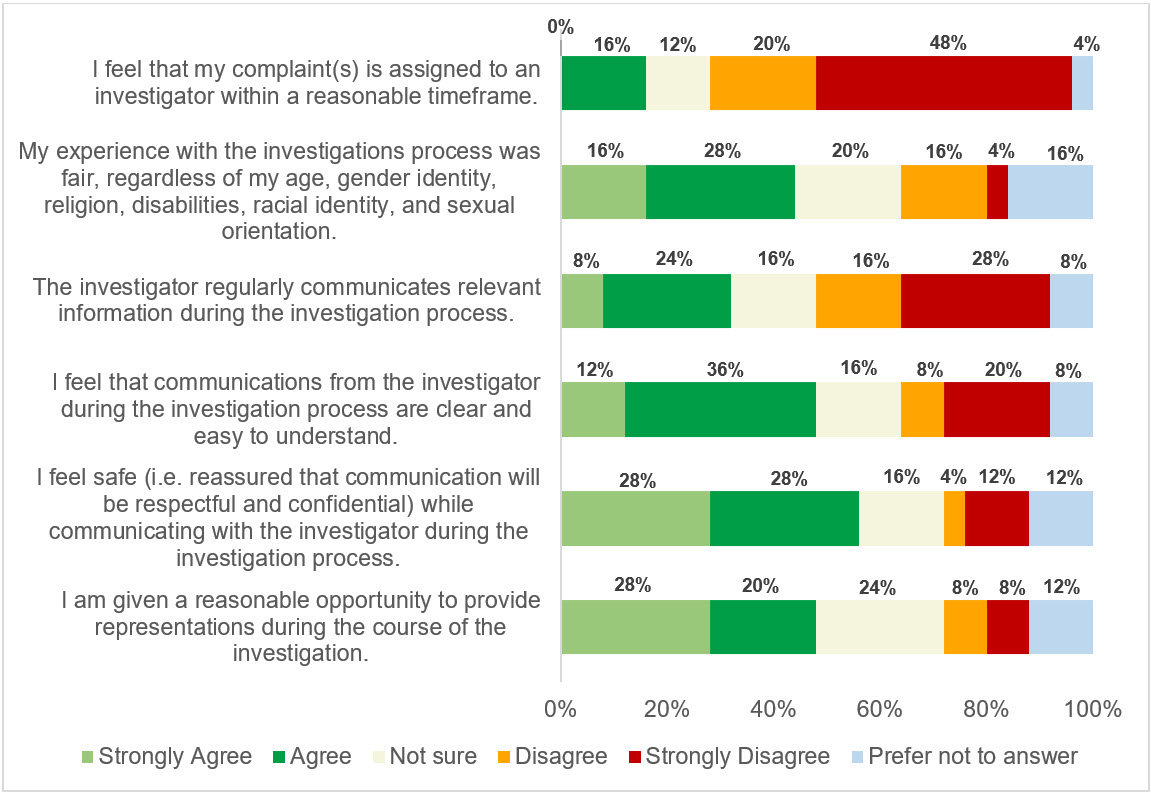
Text version
This bar chart shows the results by percentage to the following statements.
I feel that my complaint(s) is assigned to an investigator within a reasonable timeframe: 0% Strongly Agree, 16% Agree, 12% Not Sure, 20% Disagree, 48% Strongly Disagree, 4% Prefer not to answer
My experience with the investigations process was fair, regardless of my age, gender identity, religion, disabilities, racial identity, and sexual orientation: 16% Strongly Agree, 28% Agree, 20% Not Sure, 16% Disagree, 4% Strongly Disagree, 16% Prefer not to answer
The investigator regularly communicates relevant information during the investigation process: 8% Strongly Agree, 24% Agree, 16% Not Sure, 16% Disagree, 28% Strongly Disagree, 8% Prefer not to answer
I feel that communications from the investigator during the investigation process are clear and easy to understand: 12% Strongly Agree, 36% Agree, 16% Not Sure, 8% Disagree, 20% Strongly Disagree, 8% Prefer not to answer
I feel safe (i.e. reassured that communication will be respectful and confidential) while communicating with the investigator during the investigation process: 28% Strongly Agree, 28% Agree, 16% Not Sure, 4% Disagree, 12% Strongly Disagree, 12% Prefer not to answer
I am given a reasonable opportunity to provide representations during the course of the investigation: 28% Strongly Agree, 20% Agree, 24% Not Sure, 8% Disagree, 8% Strongly Disagree, 12% Prefer not to answer
Areas of Strengths
- 44% (11) of questionnaire respondents “strongly agree” or “agree” that the investigation process was fair regardless of their personal identities.
- 48% (12) of questionnaire respondents “strongly agree” or “agree” that communications during the investigation process are clear and easy to understand.
- Additionally, 56% (14) of respondents “strongly agree” or “agree” that they feel safe while communicating with investigators. Some (3) respondents mentioned in their comments that investigators are helpful and understanding. Focus group participants echoed similar sentiments about investigators and expressed having positive and strong relationships with them. Complainants gain a better understanding of investigators’ interpretations of the Act when the communications are frequent.
Improvement Opportunities
- 48% (12) of questionnaire respondents “strongly disagree” that their complaints are assigned to an investigator within a reasonable timeframe. Several respondents additionally stated that it takes too long for an investigator to be assigned to their case. They mentioned that it could take a few months to a few years for an assignment. Given the scope of this report, it is impossible to make recommendations related to the OIC’s allocation of resources or investigation process efficiency. That said, these comments suggest the need to increase capacity in order to assign investigations more quickly.
- While 32% (8) of questionnaire respondents “strongly agree” or “agree” with the statement that the investigator regularly communicates relevant information during the investigation process, 44% (11) of them “strongly disagree” or “disagree” with it. Some respondents mentioned that there is no regular communication from the investigator and that the investigators are not always responsive, especially if they know of a complainant making several complaints. This indicates the need for timely and regular communications from investigators.
- Some questionnaire respondents mentioned that they are not sure of the criteria used for prioritization of complaints. Thus, there is a need to improve the communication on how the OIC prioritizes complaints. Some focus group participants recommended consistency in process and communication approaches be adopted by all investigators.
- Two (2) questionnaire respondents mentioned that they have faced challenges such as “gaslighting” and stalling from investigators, which indicates the opportunity for additional training for investigators. Focus group participants shared perceptions of investigators favouring institutions coupled with the complainant’s perception that investigators do not understand institutions’ processes in certain cases.
- Several focus group participants reported their perception that the OIC does not investigate, or does not investigate in a timely manner, complaints alleging that the time extension the institution has taken under section 9 of the Act is unreasonable.
2.7 Investigation Conclusion
Twenty five questionnaire (25) respondents answered this section and 12 of them left comments.
The final report issued by the Commissioner does provide clear rationale for several complainants, but there is a need for faster processing of complaints and issuing the final report.
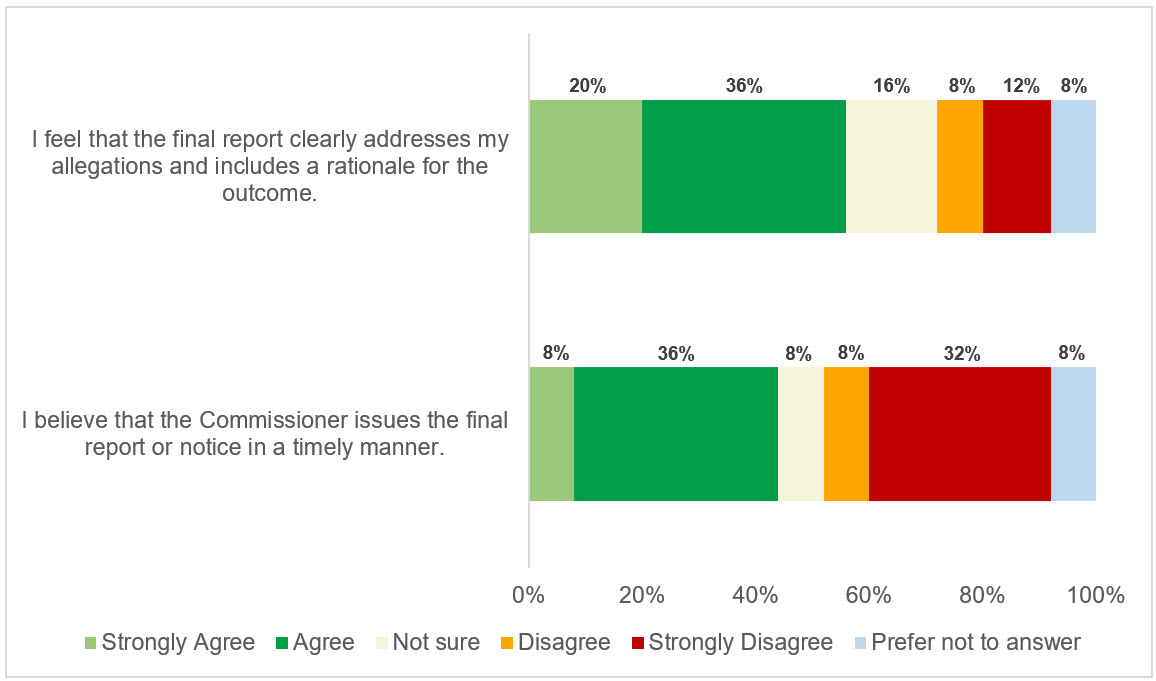
Text version
This bar chart shows the results by percentage to the following statements.
I feel that the final report clearly addresses my allegations and includes a rationale for the outcome: 20% Strongly Agree, 36% Agree, 16% Not Sure, 8% Disagree, 12% Strongly Disagree, 8% Prefer not to answer
I believe that the Commissioner issues the final report or notice in a timely manner: 8% Strongly Agree, 36% Agree, 8% Not Sure, 8% Disagree, 32% Strongly Disagree, 8% Prefer not to answer
Areas of Strengths
- 36% (9) of questionnaire respondents “agree” and 20% (5) “strongly agree” that the final report addresses their allegations and includes a rationale for the outcome.
Improvement Opportunities
- Some (4) questionnaire respondents mentioned that the report does not always provide a clear rationale underlying the decisions and that they would like the OIC to make available real-time/up-to-date statistics on closed investigations on its Website.
- 32% (8) of questionnaire respondents “strongly disagree” and 8% (2) “disagree” that the Commissioner issues the final report or notice in a timely manner. Some respondents mentioned that, at times, it takes several years to get the final report and that it is not helpful after so much time has passed.
3. Key Takeaways: Strengths and Areas for Improvement in the Investigations Program
The results helped identify the following key strengths and areas for improvement in the Investigations Program at the OIC:
Strengths
- Communications: OIC’s communications at different stages of the Investigations Program are clear and easy to understand for complainants. Additionally, the OIC’s website lays out and outlines content in an easy-to-understand manner.
- Representations: Complainants can submit representations and share additional information during the Registry and investigation stages, which makes their experiences positive.
- Overall Investigation Process: The investigation process is fair, barrier-free, and safe for complainants overall and the complainant’s personal identities do not affect the decisions that are made after the complaint is filed.
Areas for Improvement
- Technical Advancement: There is an opportunity for the OIC to improve the technical aspects of its website by developing a process to regularly check if the links and forms on the website are functioning, improving search and other functionalities, integrating a case management system for individuals to track their own investigations and providing worldwide access to the website and complaint form.
- Improving Information Sharing: The OIC can improve the information it shares with complainants, for example by making available real-time/up-to-date statistics on closed investigations on its Website. Additionally, there is an opportunity to update and publish the Investigator’s Guide to Interpreting the Act.
- Shortening Timelines: Lengthy timelines throughout the investigation process have been identified to be a key challenge. The complaint registration process, file assignment and the investigations processes were all identified as being challenging. Given the scope of this report, it is impossible to make recommendations related to the OIC’s allocation of resources or investigations process efficiency. That said, the OIC should consider resourcing implications and re-evaluating some of the sub-processes to identify efficiencies.
- Promoting Inclusive Behaviour from Staff: Some (2) of the complainants mentioned facing unacceptable behaviour from staff members. Therefore, while most participants confirmed that interactions with investigations and registry staff are positive, there is an opportunity to enhance staff members’ understanding of inclusive communications and behaviour and adopting a trauma-informed lens in their work.
- Enhancing Flexibility in Investigation Processes: If possible, the OIC may consider increasing flexibility to the 60-day timeline for complainants to file a complaint after they become aware of the issue. This would enhance the experience of individuals who might not have been able to file a complaint within this timeframe due to personal reasons.
- Managing Change: The OIC may consider adopting more timely, frequent, and clear communications when implementing any change to manage expectations of internal and external stakeholders.
4. Recommendations
4.1 Develop and Implement a client-facing Complaint Management System
To improve communication with complainants and to offer real-time access to investigation updates, the OIC should consider introducing an online client-facing investigation management system. The system can be used by complainants with password-protected online accounts, ability to track progress of investigations, monitor deadlines, and upload and download documents and communicate with investigators.
Key action items:
- Assess internal capabilities, feasibility, resource requirements and impacts of introducing a client-facing investigation management system.
- Identify and assess available system options to choose most aligned to priorities and needs.
- Work with change management consultants to manage changes internally and externally for a smooth integration and acceptance of the system by stakeholders.
4.2 Improve the OIC Website
To improve the user experience for individuals using the OIC’s website, the OIC should consider making the following technical advancements:
- Add an auto-save feature and/or increasing the timeout duration for online complaint forms.
- Make the website and online complaint forms accessible internationally.
- Introduce a helpdesk on the website to enhance relationships and build faster communication between the OIC and complainants. If possible, consider adding a “live chat” and/or chatbot feature.
- Integrate a procedure for regular checks on website links and their functionalities.
Key action items:
- Identify financial, human and technological resources required for technical changes.
4.3 Standardize and Optimize Investigation Processes
To improve standardization of complainant interactions with Registry staff and investigators, the OIC should consider the following:
Key action items:
- Work with a third-party to develop a standardized procedure for investigators with interpretations of the Act and scenario-based analysis.
- Gather feedback from investigators to identify their challenges to make the procedure more efficient for them.
- Provide training to investigators on the following topics: inclusive communications, bias recognition and psychological safety.
4.3 Improve Collaboration and Communication with Institutions
To strengthen relationships with institutions the OIC should consider the following:
Key action items:
- Identify key contacts within institutions for regular communications and engagement.
- Send monthly or quarterly communications to institutions highlighting the importance adhering to the Act, including timeliness of responses and limited and specific exemptions.
- Seek to gain insight into institution procedures to enhance investigators’ understanding.
4.4 Simplify the Interpretation of the Act
To ensure complainants understand the requirements of the Act, the OIC should consider the following:
Key action items:
- Update and publish the Investigator’s Guide to Interpreting the Act.
- Include real-life examples and scenarios to illustrate the interpretation of different sections of the Act.
4.5 Publish Investigation Outcomes
To improve the timeliness of publication of information the OIC should make available real-time/up-to-date statistics on closed investigations on its Website:
Key action items:
- Assess the resource implications of publishing this data more than once per year (i.e., Annual Report).
4.6 Change Management
To improve communication and implementation of process or policy changes, the OIC should consider the following:
Key action items:
- Define the changes and their impacts on stakeholders.
- Communicate with stakeholders in a proactive manner, in advance of changes being implemented.
- Create a change management team and/or work with specialists to integrate a change management plan.
- Identify and provide relevant training and information to impacted stakeholders.
4.7 Advocate for Improvements to the Act
To improve the Access to Information Act, the Commissioner should consider advocating for the following amendments:
- Establishing mechanisms for increasing institutions’ accountability.
- Embedding flexibility in 60-day timeframe to make a complaint.
- Limiting the time extensions granted to institutions.
- Defining information that can be released by institutions.
Appendix I: Self-Identification of Complainants
The graphs in this section provide a summary of the responses received for the self-identification questions of the complainants.
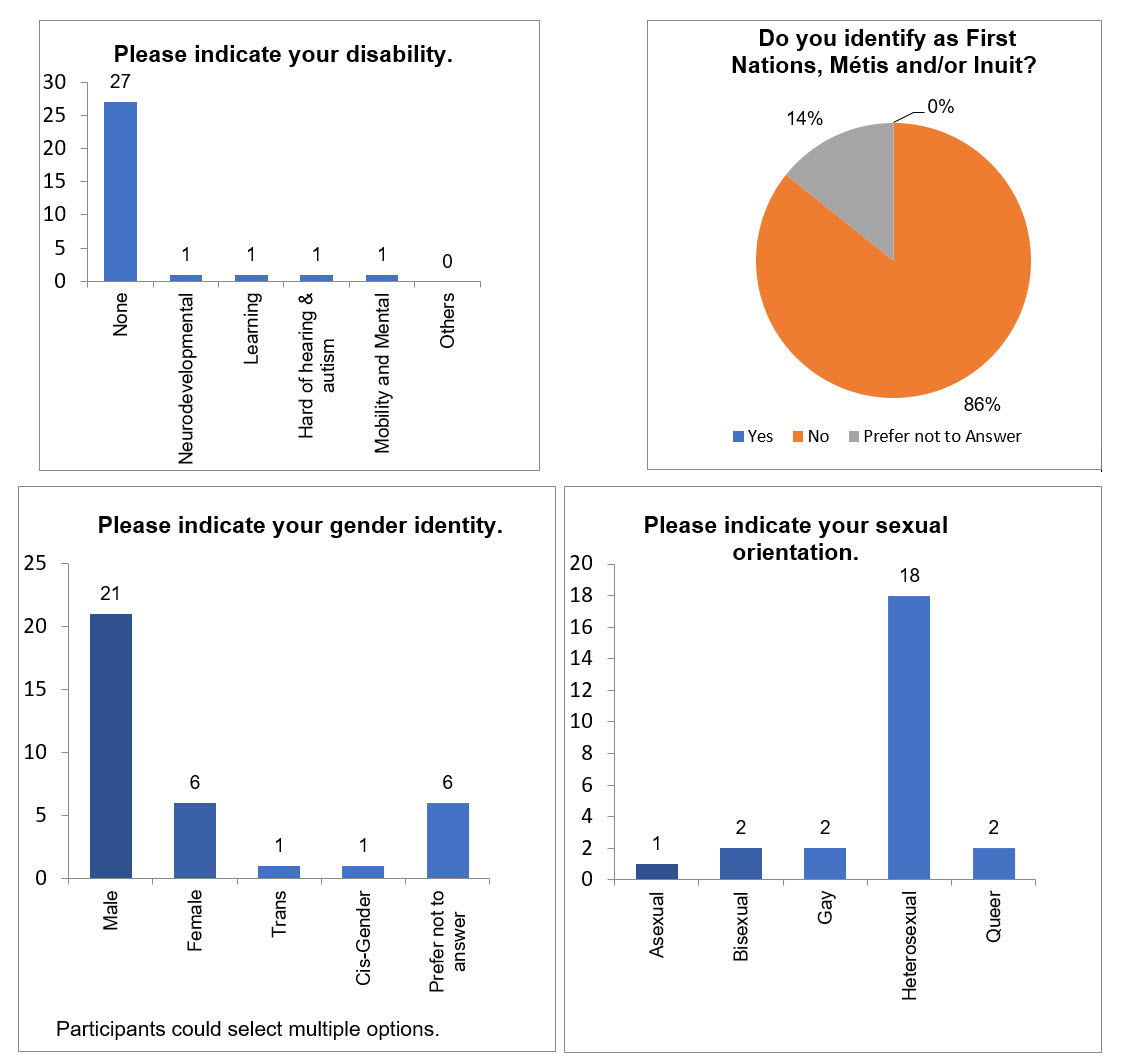
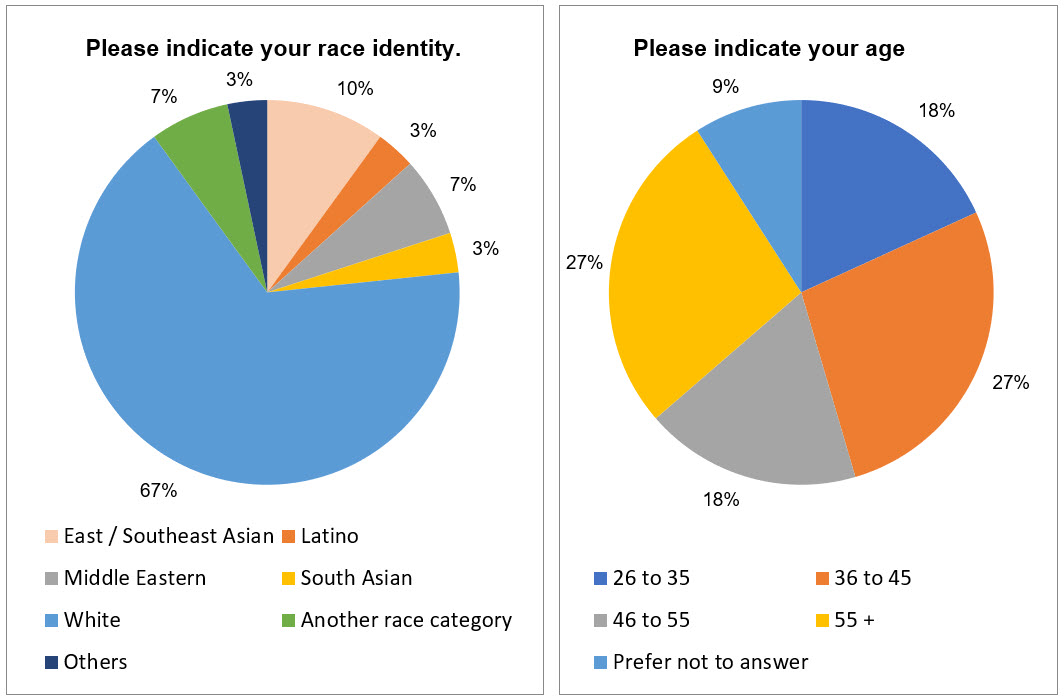
Text version
This bar graph shows the number of respondents indicating a disability: 27 None, 1 Neurodevelopmental, 1 Learning, 1 Hard of hearing & autism, 1 Mobility and Mental, 0 Other
This pie chart shows the number of respondents indicating whether they identify as First Nations, Métis and/or Inuit: 0% Yes, 86% No, 14% Prefer not to answer
This bar graph shows the number of respondents indicating their gender identity: 21 Male, 6 Female, 1 Trans, 1 Cis-Gender, 6 Prefer not to answer
This bar graph shows the number of respondents indicating their sexual orientation: 1 Asexual, 2 Bisexual, 2 Gay, 18 Heterosexual, 2 Queer
This pie chart shows the number of respondents indicating their race identity: 10% East/Southeast Asian, 3% Latino, 7% Middle Eastern, 3% South Asian, 67% White, 7% Another race category, 3% Other
This pie chart shows the number of respondents indicating their age: 18% 26 to 35, 27% 36 to 45, 18% 46 to 55, 27% 55 +, 9% Prefer not to answer
Appendix II: Questionnaire
The graphs in the section provide a summary of the responses received for the self-identification question of the complainants.
Office of the Information Commissioner of Canada’s Website
- The OIC communicates the information I need on its website.
- Strongly Disagree
- Disagree
- Agree
- Strongly Agree
- Not sure
- Prefer not to answer
- The OIC’s website is easy to understand.
- Strongly Disagree
- Disagree
- Agree
- Strongly Agree
- Not sure
- Prefer not to answer
- The signage, images and language used on the OIC’s website are inclusive and consider my unique cultural, spiritual, gender-identity or physical ability needs.
- Strongly Disagree
- Disagree
- Agree
- Strongly Agree
- Not sure
- Prefer not to answer
- It is easy to find the information I need on the OIC’s website.
- Strongly Disagree
- Disagree
- Agree
- Strongly Agree
- Not sure
- Prefer not to answer
Please provide feedback about the OIC’s website: text box
Submitting a Complaint
The Access to Information Act provides a right to complain to the Information Commissioner about matters related to an access request made under the Act.
Individuals may also complain about other matters related to requesting and obtaining access to records under Part 1 of the Act, even if they did not make an access request.
Whether you have used the online complaint form and/or submitted your complaint by email or mail, we would appreciate your thoughts. Please share any feedback or suggestions you may have.
- I feel that the OIC website helps me to determine when I should submit a complaint.
- Strongly Disagree
- Disagree
- Agree
- Strongly Agree
- Not sure
- Prefer not to answer
- I feel that the OIC website helps me to determine what I can complain about.
- Strongly Disagree
- Disagree
- Agree
- Strongly Agree
- Not sure
- Prefer not to answer
- I feel that the complaint forms help me communicate what I am complaining about.
- Strongly Disagree
- Disagree
- Agree
- Strongly Agree
- Not sure
- Prefer not to answer
- I feel that the complaint forms are easy to use.
- Strongly Disagree
- Disagree
- Agree
- Strongly Agree
- Not sure
- Prefer not to answer
- I feel that making a complaint to the OIC is a barrier-free process.
Barrier means anything — including anything physical, architectural, technological or attitudinal, anything that is based on information or communications or anything that is the result of a policy or a practice — that hinders the full and equal participation in society of persons with an impairment, including a physical, mental, intellectual, cognitive, learning, communication or sensory impairment or a functional limitation. See the Accessible Canada Act.
- Strongly Disagree
- Disagree
- Agree
- Strongly Agree
- Not sure
- Prefer not to answer
Please provide feedback about Submitting a Complaint: text box
About the Respondent
- Have you ever submitted a complaint to the OIC?
- Yes [Directed to Question 11]
- No [Directed to Question 28]
- How many complaints have you submitted to the OIC to date?
- 1-10
- 11-20
- 21-100
- More than 100
- When did you submit your last complaint to the OIC?
- 2023
- 2020-2022
- 2015-2019
- 2015 or earlier
The Registry Admissibility Process
The OIC’s Registry receives all complaints and informs the complainant if their complaint is admissible, asks for additional information if needed and/or sends a Notice of Intention to investigate to the complainant and the institution.
- I feel that the Registry admissibility process is easy to follow.
- Strongly Disagree
- Disagree
- Agree
- Strongly Agree
- Not sure
- Prefer not to answer
- I feel that the Registry communicates its decisions to complainants in a timely manner.
- Strongly Disagree
- Disagree
- Agree
- Strongly Agree
- Not sure
- Prefer not to answer
- I feel that communications from the Registry are clear and easy to understand.
- Strongly Disagree
- Disagree
- Agree
- Strongly Agree
- Not sure
- Prefer not to answer
- I feel that the Registry allows a reasonable amount of time to provide the information and documentation it is requesting.
- Strongly Disagree
- Disagree
- Agree
- Strongly Agree
- Not sure
- Prefer not to answer
- Have you made a complaint to the OIC that was inadmissible?
- Yes [Directed to Question 18]
- No [Directed to Question 19]
- I believe that the Registry provides a clear rationale when it determines that a complaint is inadmissible.
- Strongly Disagree
- Disagree
- Agree
- Strongly Agree
- Not sure
- Prefer not to answer
- Please provide feedback about the Registry Admissibility Process: text box
Complaint Assignment and Investigation
Once the Registry determines that a complaint is admissible and has sent the Notice of intention to investigate to the parties, an investigator is assigned to the complaint and carries out the analysis, gathering more information as necessary.
- I feel that my complaint(s) is assigned to an investigator within a reasonable timeframe.
- Strongly Disagree
- Disagree
- Agree
- Strongly Agree
- Not sure
- Prefer not to answer
- My experience with the investigations process was fair, regardless of my age, gender identity, religion, disabilities, racial identity, and sexual orientation. See: prohibited grounds of discrimination at Canada Human Rights Act
- Strongly Disagree
- Disagree
- Agree
- Strongly Agree
- Not sure
- Prefer not to answer
- The investigator regularly communicates relevant information during the investigation process.
- Strongly Disagree
- Disagree
- Agree
- Strongly Agree
- Not sure
- Prefer not to answer
- I feel that communications from the investigator during the investigation process are clear and easy to understand.
- Strongly Disagree
- Disagree
- Agree
- Strongly Agree
- Not sure
- Prefer not to answer
- I feel safe (i.e., reassured that communication will be respectful and confidential) while communicating with the investigator during the investigation process.
- Strongly Disagree
- Disagree
- Agree
- Strongly Agree
- Not sure
- Prefer not to answer
- I am given a reasonable opportunity to provide representations during the course of the investigation.
- Strongly Disagree
- Disagree
- Agree
- Strongly Agree
- Not sure
- Prefer not to answer
Please provide feedback about Complaint Assignment and Investigation: text box
Investigation Conclusion
Once the investigation is completed, the Commissioner issues a final report or notice to the complainant, the institution against which the complaint is made, and other parties.
- I believe that the Commissioner issues the final report or notice in a timely manner.
- Strongly Disagree
- Disagree
- Agree
- Strongly Agree
- Not sure
- Not applicable
- Prefer not to answer
- I feel that the final report clearly addresses my allegations and includes a rationale for the outcome.
- Strongly Disagree
- Disagree
- Agree
- Strongly Agree
- Not sure
- Prefer not to answer
Please provide feedback about the investigation conclusion: text box
- If you would like to participate in a virtual/online focus group discussion hosted by KPMG to further discuss your experiences with the OIC, please enter your email address or telephone number and KPMG will get in touch with you. The focus group will be conducted via Microsoft Teams and you can join online or dial-in from your phone. Your participation in these discussions and responses will remain confidential and only the key findings will be shared with the Commissioner.
Self-Identification Questions
The purpose of these questions is to gather data on the demographic characteristics of complainants, which will enable the OIC to make the investigations process accessible for all. Please note that these questions are not mandatory, and you may choose to not answer any or all of them.
- Please indicate your current age range
- Less than 25
- 26 to 35
- 36 to 45
- 46 to 55
- 55 +
- Prefer not to answer
- Please indicate your disability.
Disability means any impairment, including a physical, mental, intellectual, cognitive, learning, communication or sensory impairment — or a functional limitation — whether permanent, temporary or episodic in nature, or evident or not, that, in interaction with a barrier, hinders a person’s full and equal participation in society. See Accessible Canada Act.
- None
- Text box:
- Please indicate your gender identity. (Select all that apply)
- Male
- Female
- Two Spirit
- Trans
- Non-Binary
- Genderfluid
- Gender Non-conforming
- Questioning
- Cis-gender (a person’s sense of their gender identity corresponds with their sex assigned at birth)
- Prefer to self-identify
- Prefer not to answer
- Please indicate your sexual orientation.
See 2SLGBTQI+ terminology – Glossary and common acronyms
- Asexual
- Bisexual
- Gay
- Heterosexual
- Lesbian
- Pansexual
- Queer
- Questioning
- Two-Spirit
- Prefer to self-describe
- Prefer not to answer
- Do you identify as First Nations, Métis and/or Inuit?
- No
- First Nations
- Métis
- Inuit
- Prefer not to answer
- Please indicate which best describes your ethnic/national heritage and/or cultural background.
- Black (African, Afro-Caribbean, African Canadian descent)
- East / Southeast Asian (Chinese, Korean, Japanese, Taiwanese, Filipino, Vietnamese, Cambodian, Thai, Indonesian, other Southeast Asian descent)
- Indigenous (First Nations, Métis, Inuit descend)
- Latino (Latin American, Hispanic descent)
- Middle Eastern (Arab, Persian, West Asian descent e.g., Afghan, Egyptian, Iranian, Lebanese, Turkish, Kurdish etc.)
- South Asian (South Asian descent e.g., East Indian, Pakistani, Bangladeshi, Sri Lankan, Indo-Caribbean, etc.)
- White (European descent)
- Another race category: _______Another racial identity (Note: Respondents - please select as many of the above categories as apply instead of writing identifiers such as ‘mixed’ or ‘bi-racial’)
- Prefer not to answer
Appendix III: Focus Group Guide
Here are the questions from the Focus Group Guide:
| Categories | Questions | |
|---|---|---|
| 1. | OIC’s Website |
|
| 2. | Submitting a Complaint |
|
| 3. | The Registry Admissibility Process |
|
| 4. | Complaint Assignment & Investigation |
|
| 5. | Investigation Conclusion |
|